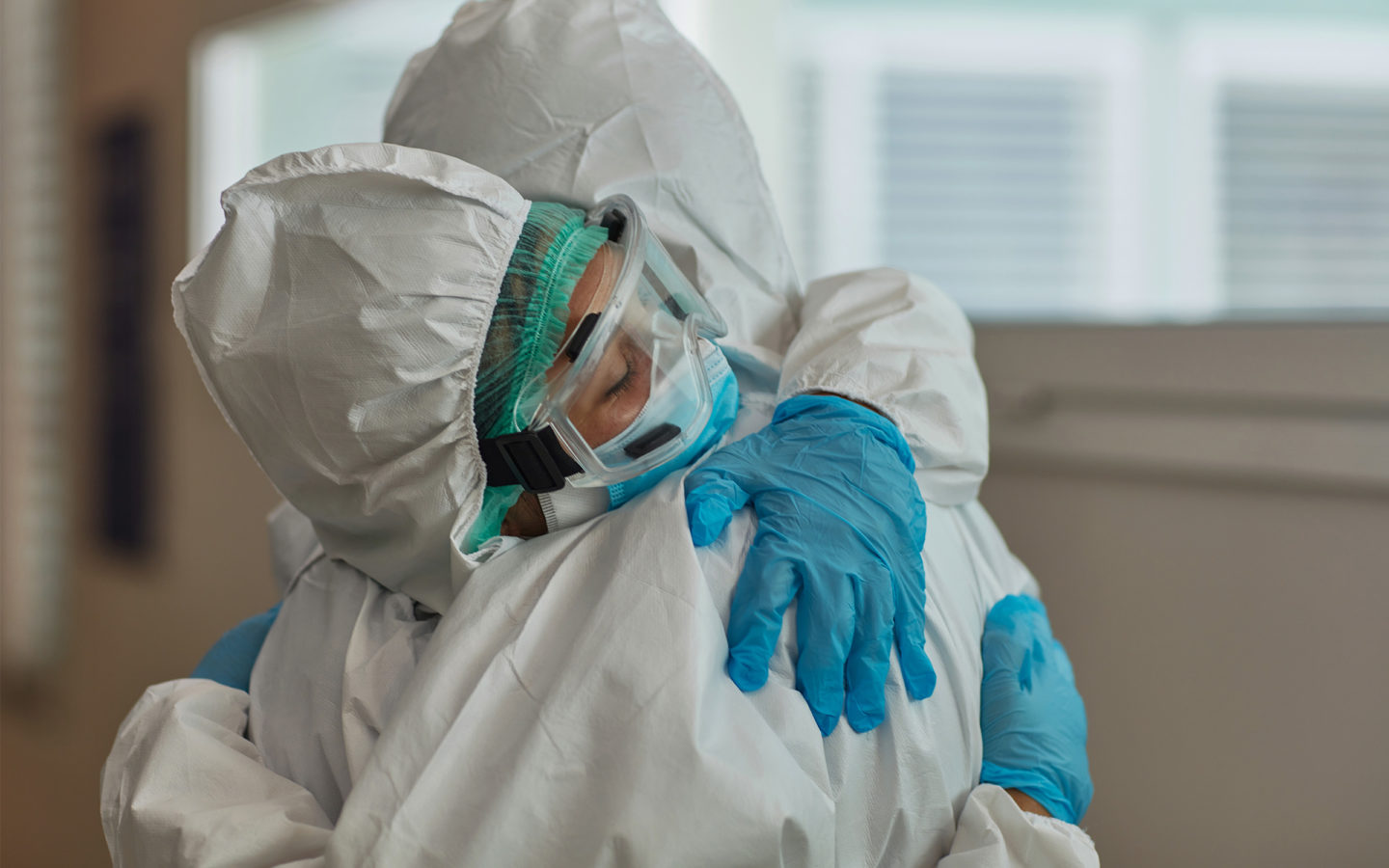- As nurses we bear witness to trauma often, and our ability to stay resilient is a point of pride.
- But we are more than twice as likely experience PTSD, which can have long-lasting impacts on our health and happiness.
- PTSD can look similar to burnout, but they aren’t the same––PTSD Is a diagnosable mental health disorder, and it requires a specific set of resources and treatment.
- Start a conversation, check-in with your fellow nurses, and normalize getting help when struggling with PTSD.
Nurses are tough – it’s in our DNA.
In our line of work, we see a lot. Our ability to stay resilient is a point of pride, but it’s not exactly a choice. Often there just isn’t time to process what we’ve experienced, because there’s always another patient waiting.
In the moment, the ability to push through may be the very thing that serves us and our patients best. But when the shift is over, there are real and serious consequences for our physical and mental health.
And we’re not just talking about burnout. We’re talking about trauma.
Trauma and post-traumatic stress disorder (PTSD) are not as well understood as burnout in nursing, and they are also more stigmatized. But PTSD actually has more lasting health consequences. It’s extremely distressing and highly disruptive to nurses’ quality of life, both in and out of scrubs.
That’s why it’s so important that we break down the stigma and start talking about the impact and prevalence of trauma in our field. We have to talk about the things we’ve seen, the devastated parent we can’t forget, the patients we still dream about at night. We need to talk about these things with our colleagues, our administrators, and with you – and maybe you need to talk about it too.
Burnout or PTSD?
Burnout syndrome is emotional exhaustion due to chronic overwork. It has serious consequences of its own. But PTSD is different – it’s a diagnosable mental health disorder, and it requires a very specific set of resources and treatment.
Research on PTSD is limited, though, because it wasn’t recognized as an official diagnosis until the late 1970s. Even now there is still a misconception that PTSD is experienced exclusively by those in the military. In fact, it was previously known as “shell shock” or “combat fatigue.”
But as research on trauma and PTSD has advanced, there’s an increased awareness of how pervasive trauma really is.
Trauma can occur as a result of a car accident or a natural disaster. It could be caused by child abuse. School shootings. An act of violence. Loss of life. Literal trauma to the body. Anyone, in any occupation, can have these experiences that leave lasting marks.
But nurses – especially those in emergency departments, intensive care units and mental health services – bear witness to and experience trauma on a near daily basis. We see trauma walk right through the front door and into our day. We see the worst moments of people’s lives. We see atrocities, horror, grief – and that’s just a Tuesday.
And now, the pandemic. We’re intubating patients who are swollen from lying prone for hours. We’re running out of ventilators and PPE. We’re holding up our personal phones and tablets so patients’ loved ones can say goodbye from a distance. And we’re intimately aware – maybe more so than anyone else – that more than 140,000 Americans have died, and almost 1,000 of them have been healthcare workers. Every shift is a risk.
Any of this – all of this – is trauma. And trauma can have serious, lasting, and devastating consequences.
How many nurses experience PTSD?
Prevalence is hard to pin down because PTSD is measured inconsistently, but it’s believed that nurses experience it at nearly twice the rate of the general population.
Not every nurse will be traumatized by a difficult situation, and similarly, not every nurse experiencing PTSD will exhibit the same symptoms. That being said, the most common symptoms of PTSD include the following:
- Re-experiencing the traumatic event
Nurses may experience intrusive thoughts, nightmares, or flashbacks. - Negative changes to cognition and mood
Low self-esteem, lack of pleasure, dissatisfaction, or numbness can occur. - Avoidance and dissociative symptoms
Avoidance symptoms can include withdrawing from people and places and avoiding thinking or talking about the event. - Hyperarousal or vigilance
These symptoms can include trouble falling or staying asleep, anxiety, trouble concentrating, and feeling quick to anger.
Now imagine a third of the nurses on your floor or unit experiencing these symptoms at any given time. Maybe you don’t have to imagine it at all. And with hardly a moment to breathe, still mourning loved ones we’ve lost and the patients we couldn’t save, many of us are diving right back into subsequent waves of the COVID-19 crisis.
Trauma is real, and it’s heavy, but we’re not helpless against it. The first step is to recognize when, as one of our SHIFT Talk guests put it, “something deeper is going on.” Is it exhaustion that passes when you take a couple of days off or a deeper sense of despondency? Is it stress that ebbs and flows with your patients’ acuity, or is it hypervigilance that follows you out of the unit, into your car, and all the way home?
Whether it’s burnout, PTSD, or another mental health issue, the next step is getting help.
Easier said than done, we know – especially when, unfortunately, studies show mental health stigma is commonplace in healthcare settings. According to the Journal of Psychiatric and Mental Health Nursing Review, nurses report experiencing contempt, ostracization, and even termination as a result of sharing their mental health experiences.
But untreated trauma doesn’t go away
This “don’t ask, don’t tell” attitude, coupled with the pressure we put on ourselves to stay strong for our patients and our families, is extremely harmful to both individual nurses and the profession as a whole. Trauma has long-lasting impacts on the brain and body – new research shows it creates physiological changes linked to conditions like depression, heart disease, and more.
PTSD doesn’t just “go away,” even in the toughest, most resilient nurses. Unresolved trauma contributes to chronic disease, substance abuse, depression and anxiety, and with more and more of us experiencing trauma as we treat COVID-19 patients, we have to speak up. We can’t just resign ourselves to this level of suffering being our new reality.
The good news is that with professional help, PTSD can be treated and managed. Many nurses who reach out for help improve significantly with treatment, even seeing all symptoms resolve over time.
The bad news is that many of our employers haven’t traditionally done a great job when it comes to supporting our mental health, including those of us experiencing PTSD. If your workplace offers an employee assistance program, these are often free and a good place to connect with professionals who can help. As the pandemic has continued, we’ve also started hearing about a lot of new programs cropping up to better address mental health issues such as bedside meditation, peer-to-peer counseling and resilience training.
Feeling too overwhelmed to engage with a formal program? That’s OK. It’s enough to grab a coworker or a family member and just start the conversation. And if you’re not experiencing symptoms like these, maybe you can keep an eye out for the nurses who are and initiate the conversation on your end. We all have to start somewhere—sometimes just taking each other by the hand and saying “I see you” makes all the difference in the world. We do it for our patients, right? Surely we can do this for each other, SHIFT Talkers.
We can – we must – be the generation of nurses that starts the conversation, breaks down the stigma, and normalizes getting help.
Here are some PTSD resources that we recommend for nurses struggling with trauma:
- Help With Posttraumatic Stress Disorder (PTSD), American Psychiatric Association
- Post-Traumatic Stress Disorder, National Institute of Mental Health
- National Helpline, Substance Abuse and Mental Health Services Administration


